21.11.2017
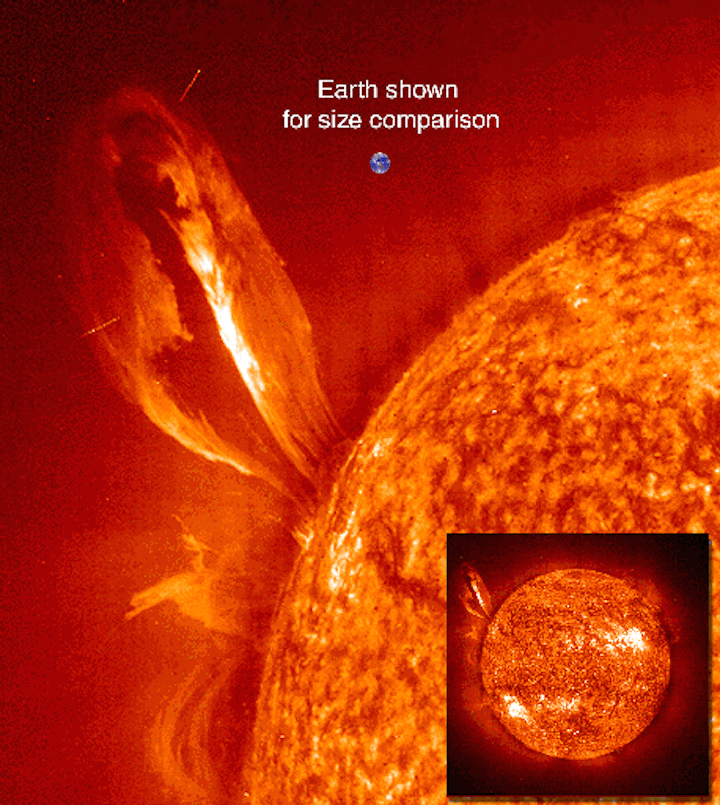
Our solar system is composed of the Sun and all things which orbit around it: the Earth, the other eight planets, asteroids, and comets. The Sun is 150 million kilometers (93 million miles) away from the Earth (this distance varies slightly throughout the year, because the Earth's orbit is an ellipse and not a perfect circle).
The Sun is an average star - there are other stars which are much hotter or much cooler, and intrinsically much brighter or fainter. However, since it is by far the closest star to the Earth, it looks bigger and brighter in our sky than any other star. With a diameter of about 1.4 million kilometers (860,000 miles) it would take 110 Earths strung together to be as long as the diameter of the Sun. The Sun is mostly made up of hydrogen (about 92.1% of the number of atoms, 75% of the mass). Helium can also be found in the Sun (7.8% of the number of atoms and 25% of the mass). The other 0.1% is made up of heavier elements, mainly carbon, nitrogen, oxygen, neon, magnesium, silicon and iron. The Sun is neither a solid nor a gas but is actually plasma. This plasma is tenuous and gaseous near the surface, but gets denser down towards the Sun's fusion core.
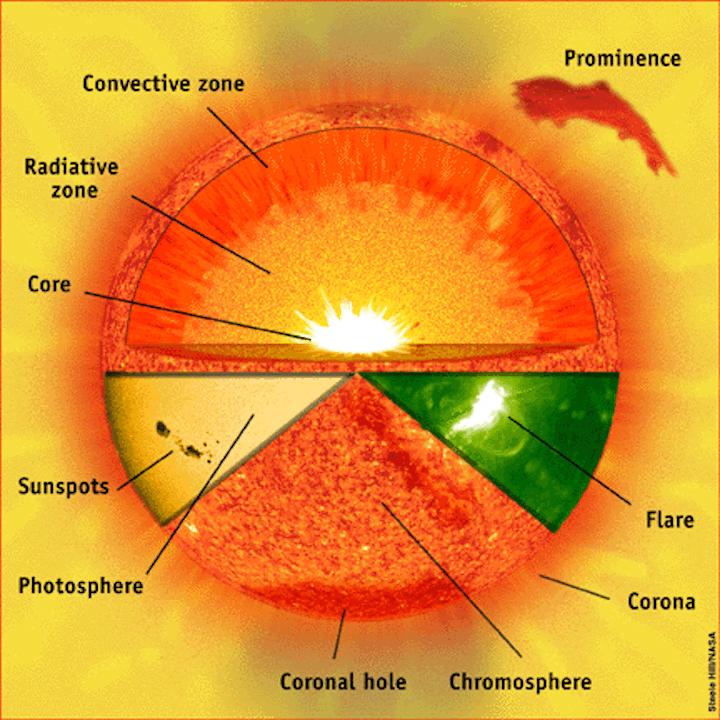
|
The Sun, as shown by the illustration to the left, can be divided into six layers. From the center out, the layers of the Sun are as follows: the solar interior composed of the core (which occupies the innermost quarter or so of the Sun's radius), the radiative zone, and the the convective zone, then there is the visible surface known as the photosphere, the chromosphere, and finally the outermost layer, the corona. |
All of the energy that we detect as light and heat originates from nuclear reactions deep inside the Sun's high-temperature "core." This core extends about one quarter of the way from the center of Sun (where the temperature is around 15.7 million kelvin (K), or 28 million degrees Fahrenheit) to its surface, which is only 5778 K "cool".
|
Above this core, we can think of the Sun's interior as being like two nested spherical shells that surround the core. In the innermost shell, right above the core, energy is carried outwards by radiation. This "radiative zone" extends about three quarters of the way to the surface. The radiation does not travel directly outwards - in this part of the Sun's interior, the plasma density is very high, and the radiation gets bounced around countless numbers of times, following a zig-zag path outward. |
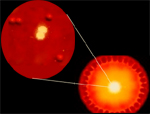 Click on the image for an animation! |
It takes several hundred thousand years for radiation to make its way from the core to the top of the radiative zone! In the outermost of the two shells, where the temperature drops below 2,000,000 K (3.5 million degrees F) the plasma in the Sun's interior is too cool and opaque to allow radiation to pass. Instead, huge convection currents form and large bubbles of hot plasma move up towards the surface (similar to a boiling pot of water that is heated at the bottom by a stove). Compared to the amount of time it takes to get through the radiative zone, energy is transported very quickly through the outer convective zone.
The Sun's visible surface the photosphere is "only" about 5,800 K (10,000 degrees F). Just above the photosphere is a thin layer called the chromosphere. The name chromosphere is derived from the word chromos, the Greek word for color. It can be detected in red hydrogen-alpha light meaning that it appears bright red. Above the surface is a region of hot plasma called the corona. The corona is about 2 million K (3.6 million degrees F), much hotter than the visible surface, and it is even hotter in a flare. Why the atmosphere gets so hot has been a mystery for decades; SOHO's observations are helping to solve this mystery.
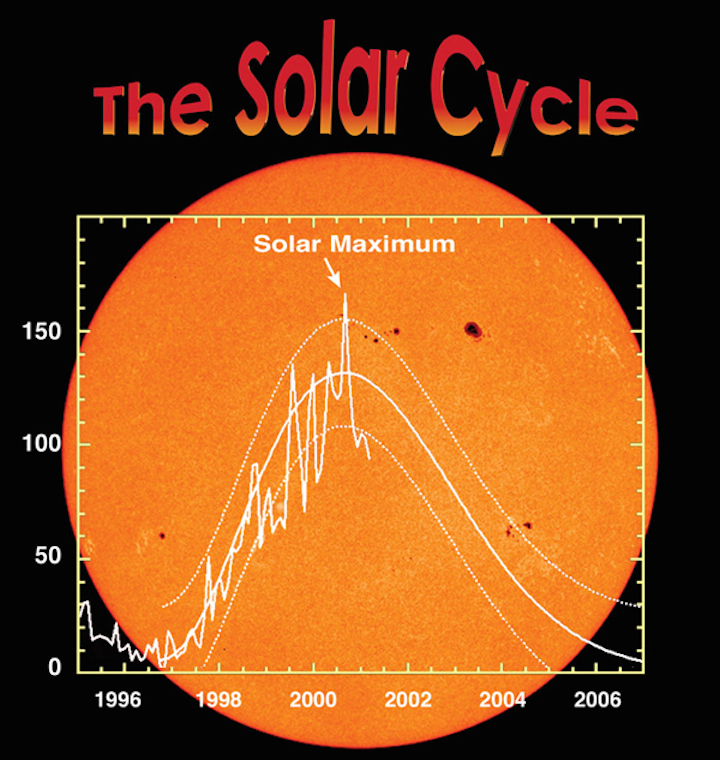
The Sun is not just a big bright ball. It has a complicated and changing magnetic field, which forms things like sunspots and active regions. The magnetic field sometimes changes explosively, spitting out clouds of plasma and energetic particles into space and sometimes even towards Earth. The solar magnetic field changes on an 11 year cycle. Every solar cycle, the number of sunspots, flares, and solar storms increases to a peak, which is known as the solar maximum. Then, after a few years of high activity, the Sun will ramp down to a few years of low activity, known as the solar minimum. This pattern is called the "sunspot cycle", the "solar cycle", or the "activity cycle".
Stars like the Sun shine for nine to ten billion years. The Sun is about 4.5 billion years old, judging by the age of moon rocks. Based on this information, current astrophysical theory predicts that the Sun will become a red giant in about five billion (5,000,000,000) years.
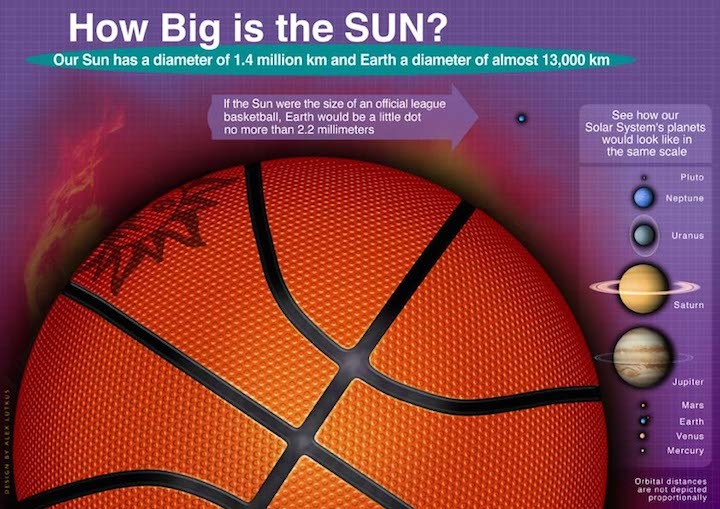

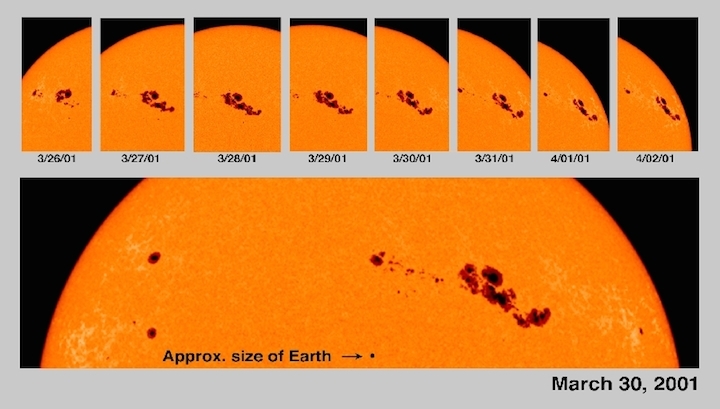
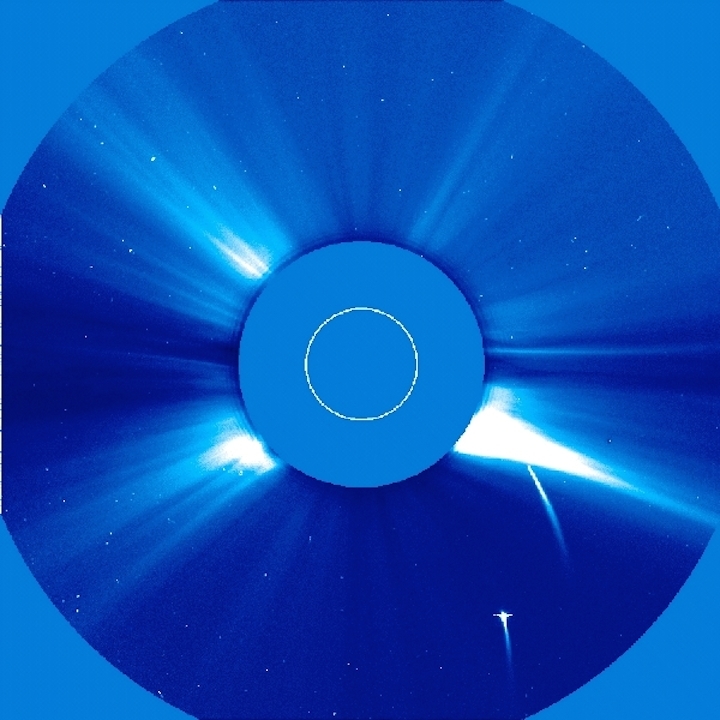
Two "Sungrazing" comets are seen heading in tandem towards the Sun’s corona. They do not reappear on the other side. The comets follow similar but not identical orbits and enter the tenuous outer atmosphere of the Sun. Shortly after the comets disappeared behind the occulting disks of the coronagraph, a bright helical-shape prominence erupts from the Sun as part of a CME. The planet Mars can be seen in the upper right corner while the bright star Aldebaran can be seen in the lower right part. Comets, composed of ice and dust, characteristically have particles streaming out behind them. Comets can be found zooming around space quite frequently.

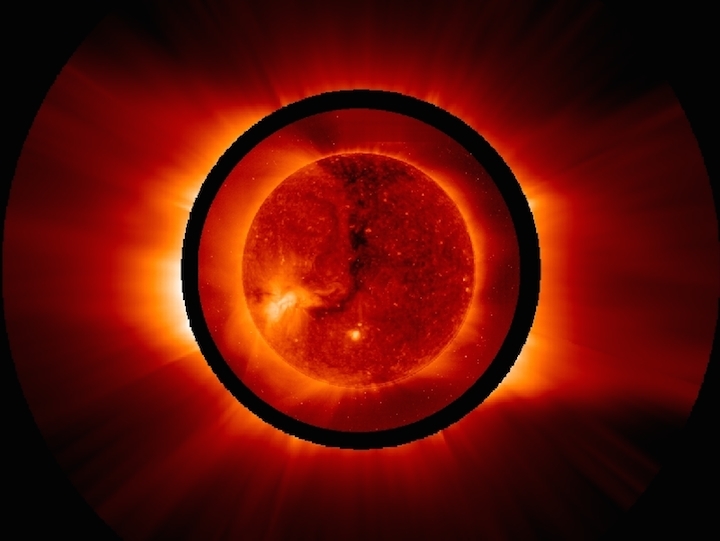
UVCS/EIT composite image. The Sun's outer atmosphere a s it appears in ultraviolet light emitted by electrically charged oxygen flowing away from the Sun to form the solar wind (region outside black circle), and the disk of the Sun in light emitted by electrically charged iron at temperatures n ear two million degrees Celsius (region inside circle). This composite image tak en by two instruments (UVCS, outer region and EIT, inner region) shows dark area s called coronal holes at the poles and across the disk of the Sun where the hig hest speed solar wind originates. UVCS has discovered that the oxygen atoms flow ing out of these regions have extremely high energies corresponding to temperatu res of over 200 million degrees Celsius and accelerate to supersonic outflow vel ocities within 1.5 solar radii of the solar surface. The structure of the corona is controlled by the Sun's magnetic field which forms the bright active regions and the ray-like structures originating in the coronal holes. The composite ima ge allows one to trace these structures from the base of the corona to millions above the solar surface.
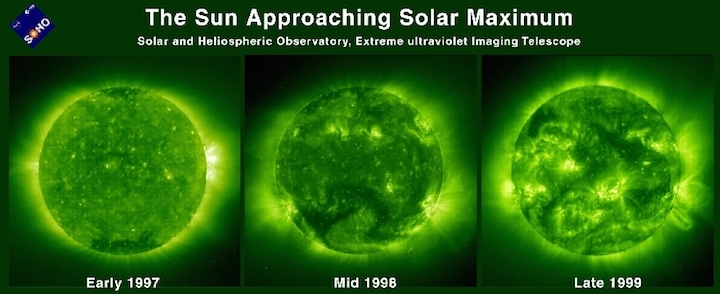
A comparison of three EIT images almost three years apart illustrates how the level of solar activity has increased significantly. The Sun attains its expected sunspot maximum of its 11-years solar cycle in the year 2000. These images are captured using Fe XII 195 Å emissions showing the solar corona at a temperature of about 1 million K. Many more sunspots, solar flares, and coronal mass ejections occur during the solar maximum. The progression towards more active regions and the number/size of magnetic loops is unmistakable.
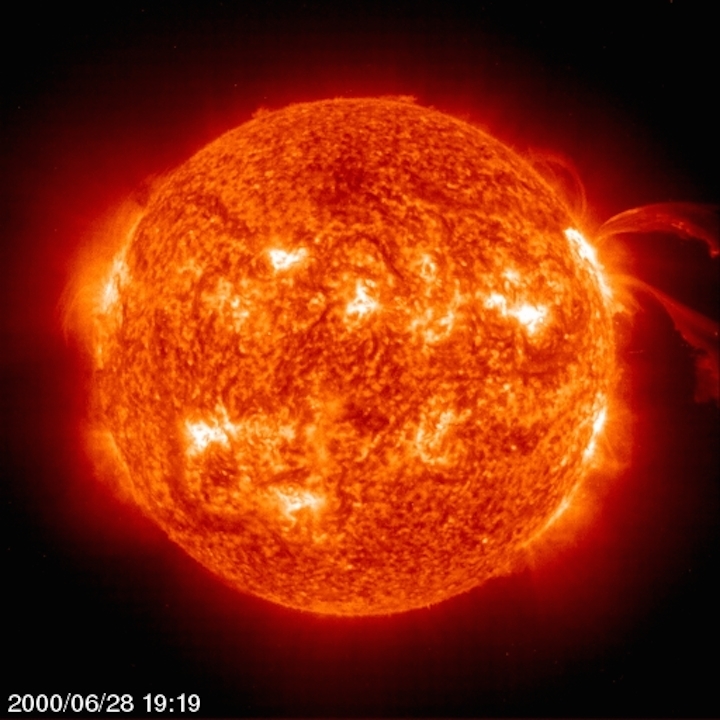
An EIT 304Å image captures a pair of curving erupting prominences on 28 June 2000 -- Prominences are huge clouds of relatively cool dense plasma suspended in the Sun's hot, thin corona. At times, they can erupt, escaping the Sun's atmosphere. Emission in this spectral line shows the upper chromosphere at a temperature of about 60,000 degrees K. Every feature in the image traces magnetic field structure. The hottest areas appear almost white, while the darker red areas indicate cooler temperatures.
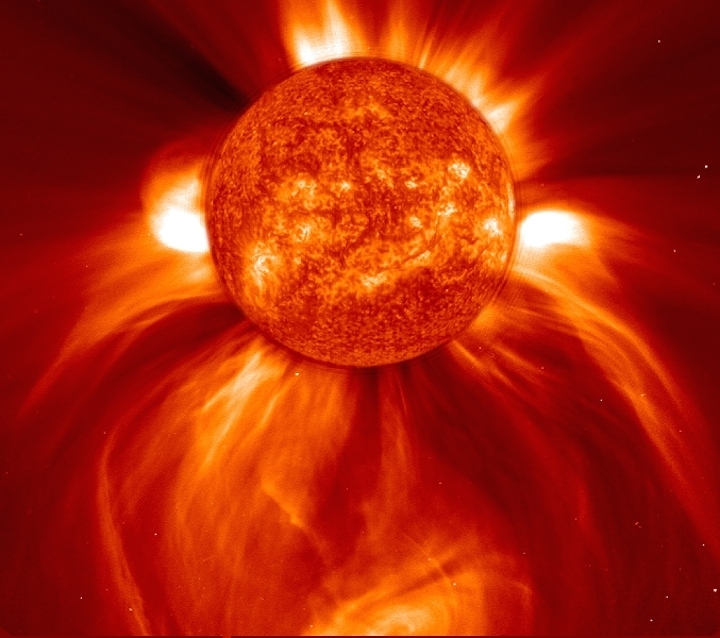
Blasting CME
This LASCO C2 image, taken 8 January 2002, shows a widely spreading coronal mass ejection (CME) as it blasts more than a billion tons of matter out into space at millions of kilometers per hour. The C2 image was turned 90 degrees so that the blast seems to be pointing down. An EIT 304 Angstrom image from a different day was enlarged and superimposed on the C2 image so that it filled the
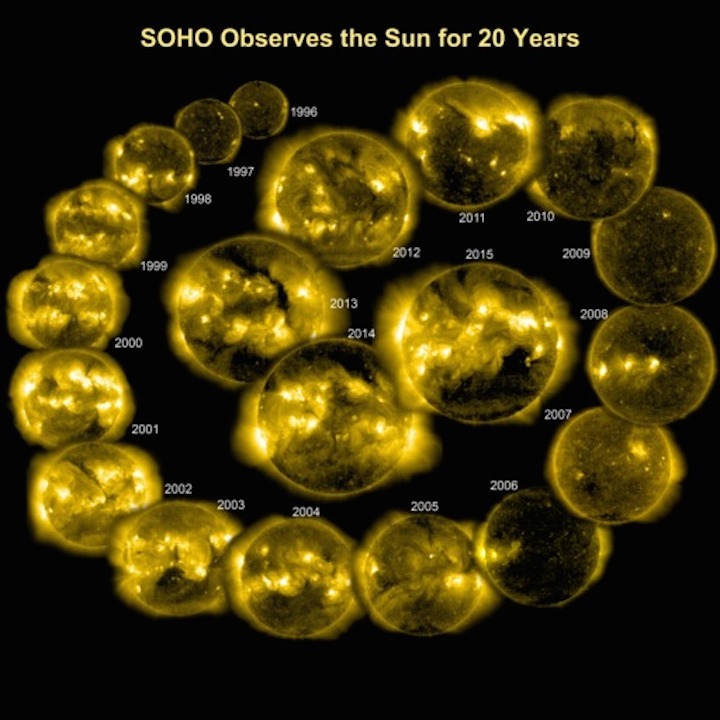
This collage of images taken in the 284 Angstrom wavelength of extreme ultraviolet light shows the Sun as it changed through almost two complete solar cycles. A solar activity cycle lasts 11 years on average. During a solar cycle the number of sunspots and level of solar activity dramatically rise and fall in a bell-shaped curve. The change is being driven by the gradual reversal of the Sun's magnetic field during that 11-year cycle. The brighter areas in the extreme ultraviolet correspond to areas of strong magnetic field. The remarkable record of long-term observations by SOHO has significantly advanced our understanding of the Sun's processes.
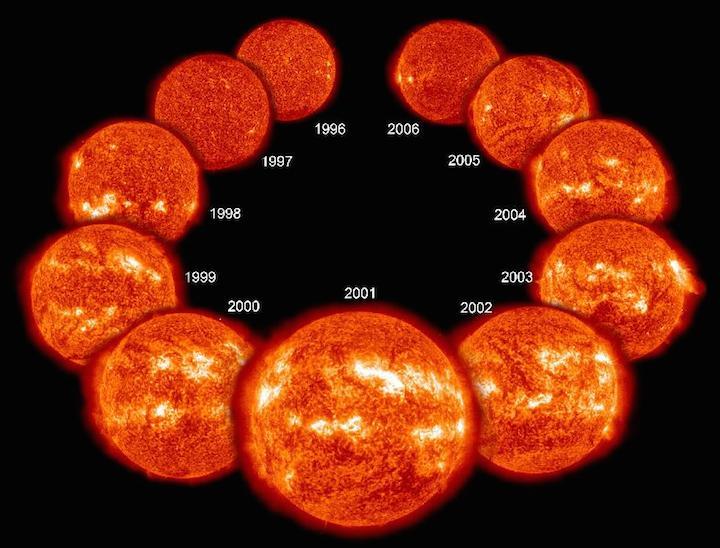
An EIT image in the 304 Angstrom wavelength of extreme UV light from each year of nearly an entire solar cycle.
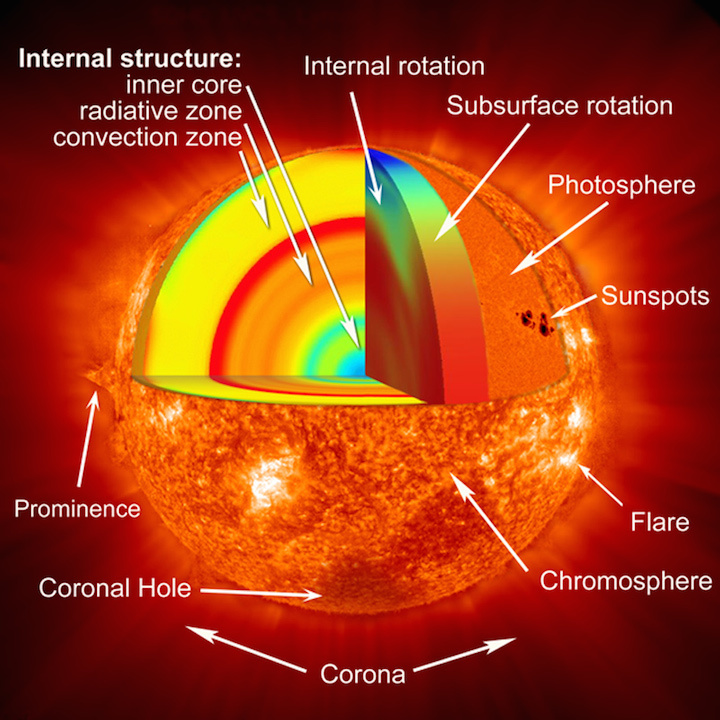
Composite image of the Sun illustrating part of the wide range of SOHO's scientific research. Left interior cutaway: Variations in the speed of sound in the deep interior as gauged by helioseismic measurements by SOHO/MDI and SOHO/VIRGO.
The conspicuous red layer, about a third of the way down from the surface to the Sun's centre, shows unexpectedly high temperatures at the transition between the turbulent outer region (convection zone) and the more stable region inside it (radiative zone). The very core of the Sun (blue) may be 0.1% cooler than the expected 15 million C. Right interior cutaway: Solar interior rotation (red: faster rotation, blue: slower rotation). The equatorial regions rotate faster than the polar regions, all the way down to the bottom of the convection zone. The radiative zone below appears to rotate at the same angular velocity (solid body rotation).
Outer cutaway: SOHO/MDI visible light image showing sunspots in the photosphere. Wrap-around: SOHO/EIT He II 304. image showing the Sun?s outer atmosphere (transition region) at a temperature of about 60,000 C.
Quelle: NASA
